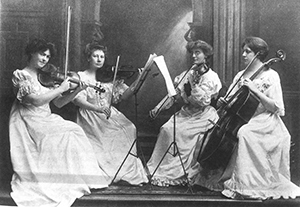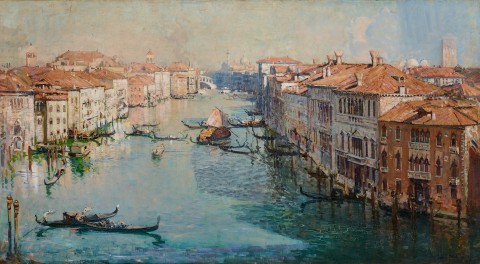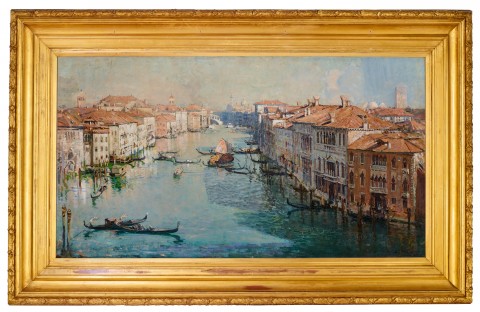THE GRAND CANAL, 1908
ARTHUR STREETON
oil on canvas
92.0 x 168.5 cm
signed lower right: A STREETON
artist’s label verso with title, artist’s name and 10 Hill Rd / Abbey Road / London N/W.
Victorian Artists Society Gallery, Melbourne
Arthur Baillieu, Melbourne, acquired from the above in 1914
Amy Shackell, Melbourne (Arthur Baillieu’s sister)
Sandra Clarke (née Shackell) , Devon Park, western Victoria from December 1957 [note attached verso]
Thence by descent
Private collection, Victoria
Salon de la Société des Artistes Français, Paris, May 1910, cat. 1728 (stamped verso and label fragment attached verso)
Mr Streeton’s Pictures, Victorian Artists Society Gallery, Melbourne, June 1914
Loan Exhibition of the Works of Arthur Streeton, National Art Gallery of New South Wales, Sydney, 20 November 1931 – 20 January 1932 (label fragment verso)
20th Century Australian Painting, Hamilton Gallery, Victoria, August 2016
A Western District Provenance – major works from private collections of the Western District of Victoria, united for thefirst time, Hamilton Gallery, Victoria, November 2018
Streeton, Art Gallery of New South Wales, Sydney, 7 November 2020 – 14 February 2021
West, W.K., ‘Streeton: Mr Arthur: An Artist from Australia’ in The Studio: An Illustrated Magazine of Fine and Applied Art, vol 47, London, 1909, pp.259 – 267 (illus.) Streeton, A., The Arthur Streeton Catalogue, Osboldstone & Co., Melbourne, 1935, no. 346 Schmidt, S., ‘A Significant Streeton Rediscovery’, Art Monthly Australasia, Issue 326, 30 December 2019, n.p. Schmidt, S., ‘A New Streeton Attribution: The Grand Canal, 1908’, Art Monthly Australasia, Issue 323, April 2020, pp. 56–61 Tunnicliffe, W. (ed.), Streeton, Art Gallery of New South Wales, Sydney, 2020, pp. 217 – 218, 230 – 231 (illus.), 37
The Grand Canal, Venice, 1908, oil on canvas, 91.0 x 152.5 cm, in Streeton, A., The Arthur Streeton Catalogue, Osboldstone & Co., Melbourne, 1935, no. 365 (Sir Robert Mond)
Grand Canal, Venice, 1927, oil on canvas, 36.0 x 66.0 cm, in the collection of the Art Gallery of New South Wales, Sydney
A BAILLIEU CENTURY: THE GRAND CANAL (1908)
Dr. Sarah Schmidt
DH2021 ART Cat (April) - 8 meg (no ads).jpg
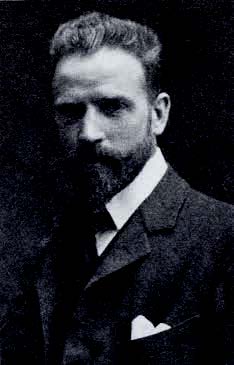
Arthur Streeton, 1901, photograph by
W. Crooke, Edinburgh
All Streeton’s powers are here concentrated… his mastery of composition and atmospheric truth, the distinction of his colour and touch – Lionel Lindsay
This painting is assuredly among Arthur Streeton’s very best, a glorious work capturing all of the splendor and beauty of Venice, monumental and with great theatrical presence. Much has been written about the famous views of the Grand Canal, painted by artists from Canaletto, to Monet1; this painting sits comfortably in the company of such masterpieces and their visual language of opalescent waterways, gondolas and landmarks of Venetian architecture. To look anew though, and to appreciate Streeton’s unique view of The Grand Canal, is to observe the stepped terracotta roofing, arranged in this picture euphoniously like a sequence of musical notes: the interconnected roofs of Venetian palaces, and other buildings. This sea of terracotta is given undeniable beauty: a key element of the vista, perfectly harmonised with the shimmering blue of both water and sky. Streeton’s technical skill is shown in orchestrating this attractive palette, carefully dominated by two complementary colours, representing the Canale Grande and an optimistic sky counterpoised with palazzo rooftops.
Streeton painted The Grand Canal from Palazzo Foscari, which present-day turisti d’arte will find ten minutes from Palazzo Venier dei Leoni, home of the Peggy Guggenheim Collection. The composition is elevated, as the scene was captured from the top of Palazzo Foscari, a fact which Streeton communicated to Baldwin Spencer in October 1908 (see p. 54).2 The elevation offers the viewer absolute command over the dazzling spectacle of the Grand Canal, which is part of the fetch of this painting. Streeton notes artist Clara Mustalba, a resident of Venice, gained him permission to paint at the Palazzo.3 When I published these findings in 2019, drawing together Venetian references from Streeton’s archives to tell the story of this painting, I could not be sure that it was this picture to which Streeton refers in the October 8 letter but my continuing research allows me to suggest it is indeed this very picture, and also the first painted, of the two works discussed in this essay.4
Arthur Streeton with easel, Venice.jpg
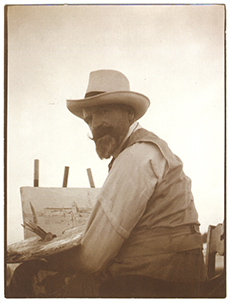
Arthur Streeton with easel, Venice, 1908
Courtesy: archival photographs of Oliver Streeton
Streeton painted most of his Venetian works in 1908: of 85 catalogue entries that year, 78 works are Venetian scenes.5 Newly married to Canadian violinist, Esther Leonora (Nora) Clench, Streeton holidayed in Venice from April to May 1908, visiting again in September to October of that year, and painting throughout each trip. Nora was a painter herself and at the turn of the century had stopped her music to travel to Paris and paint. When she resumed her violin, she started the all-female ‘Nora Clench Quartet’ which was known for ‘the most avant-garde music in London’.6 Soon after the newly-weds’ 1908 trips to Venice, Streeton held several exhibitions that featured the Venetian works: in Sydney, Melbourne, Paris, Dublin, Venice, and London, among others. The Alpine Club, London, staged a solo show in March 1909, and the Guildhall, Melbourne, presented Arthur Streeton’s Venice, in July 1909.7 The present work was not within that exhibition; it appears to have remained in Europe until at least May 1910, when it was shown at the ‘Salon de la Sociètè des Artistes Francais’, Paris.8
Streeton’s letter to Spencer9 details the picture’s size, corresponding exactly with the dimensions of the present work: ‘… I’ve painted on 66x36 from the top of Palazzo Foscari – commanding a fine view of the ‘Grand Canal.’10 This suggests that the painting was commenced during the artist’s second trip to Venice in September 1908, or the first week of October, and possibly completed in the studio in London.11 The catalogue number that the artist has given this work identifies it as the earlier of two epic pictures of this Grand Canal scene. The dimensions stated in the letter can be cross-referenced with the measurements provided through the 1914 exhibition purchase.12
Robert Mond Esquire of Sussex owned a Venetian Grand Canal painting by Streeton that shares similar grandeur to the present work.13 He and his father Ludwig were both patrons of Streeton’s work. From 1912, Ludwig hosted the artist and his wife as house guests on a number of occasions. A Mond home also became a soldiers’ hospital during the First World War, and Streeton stayed there under different circumstances.14
The current painting, the ‘Baillieu Streeton’, has a marginally broader waterway15 and slightly softer features than the Mond version, such as the angles, shadows and windows on some buildings. This gentler treatment emphasises the painting’s great achievement in Impressionist technique, and the Heidelberg School artists’ famous capture of the play of light using gestural brushstroke and colour. This work has a lightness, and almost ethereal quality that is similar to Venice, Bride of the Sea16, also painted in 1908, but a fraction of the size.
MLMSS_875_8Oct1908_venice.jpg
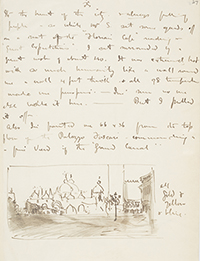
There are only two Venetian works of the scale of the present picture in The Arthur Streeton Catalogue and of his vast body of work on the Venetian theme (over eighty works), this painting is authoritatively the largest. Among his extraordinary oeuvre of over 1000 paintings, only twenty-four are of a scale comparable to The Grand Canal.
In his final (smaller) Grand Canal painting (1927) Streeton retains those key differences which distinguish the ‘Baillieu picture’ from the ‘Mond picture.’17 The main change is the magnified building in the left foreground that is introduced as a framing device; this suggests that there is a progression in the latter two pictures that the artist has chosen. The small Art Gallery of New South Wales (AGNSW) version (1927) is a spirited and lively little work despite the added building it shares with the Mond, as it is painted with rapidity and freedom. Streeton’s return to this scene in 1927 reflects the artist’s attachment to this particular view. In contrast to the Mond painting, where the view is hemmed in by the squarish building on the left, in the present work the eye glides into the waterway. The Art Gallery of South Australia has a sketch of the Grand Canal that shows a successful asymmetry, in common with the present picture.
Arthur Streeton in Piazza San Marco, Venice, 1908.jpg
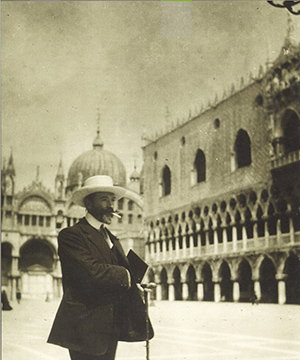
The rediscovery of this work in time for the 2020 Streeton exhibition at the AGNSW allowed Australian audiences to see the full brilliance of Streeton’s Venetian vision in a work which eclipses other paintings of the series in both scale and accomplishment.18
Until a public gallery exhibition in 2016, the painting had been out of circulation for up to 84 years. This artwork and research were brought to the attention of AGNSW writers in 2019,19 but the work had escaped the attention of earlier Streeton publications and surveys, its whereabouts had been largely unknown; in this sense it has been described as ‘the missing Streeton.’20 With the passage of time this painting has slipped from the purview of museums and art historians, from 1932 until this present century. In 1931–2 the picture was included in the Loan Exhibition of the Works of Arthur Streeton at the National Art Gallery of New South Wales (forming a wonderful arc with its major public return to exhibition at the AGNSW in 2020). This fact was discovered from a label on the painting’s verso.21 In relation to the 1931-2 exhibition, Lionel Lindsay, as then Trustee, wrote in 1935:
And that great canvas of the Grand Canal! Can I sufficiently acclaim it? All Streeton’s powers are here concentrated as in his “Centre of Empire,” his mastery of composition and atmospheric truth, the distinction of his colour and touch.22
The Grand Canal (1908) has remained in different branches of the Baillieu family, for well over a century, since Streeton sold it to Arthur Sydney Baillieu via Mr Streeton’s Exhibition of Pictures in June 1914,23 just a month before the start of the first World War.24 This picture passing by descent in the family has led to its uncontested attribution and provenance, as established in 2019: Arthur Streeton’s, The Grand Canal (1908), no. 346 in The Arthur Streeton Catalogue (1935).25 Many major Streeton works have traversed the secondary art market multiple times;26 instead this picture has been held within one family for well over a century.
Nora in Piazza San Marco.jpg
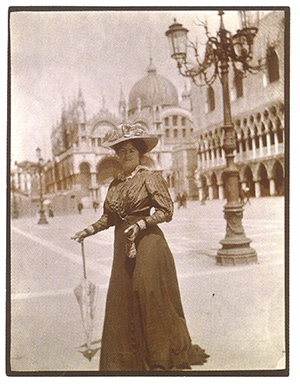
Returning to live in Australia in 1923, the Streetons were met on arrival at the wharf by Dame Nellie Melba, who encouraged them to settle in Olinda.27 In the following year she opened Streeton’s exhibition at The Fine Art Society Gallery, Melbourne.28 Melba was once described as ‘…a diva who, besides being a great musician, was also an almost royal personage. She was grand in the days that were truly grand.’29 Melba sung for royals across Europe:30 ‘no fewer than seven kings and queens attended one gala performance at Covent Gardens in 1914.’31 Hailed by her contemporaries as ‘the world’s greatest singer,’32 Melba was an ardent fan of Streeton’s work, owning several paintings.33 In 1915 she wrote to him: ‘Dear Arthur Streeton, … I have seen your lovely pictures at Professor [Baldwin] Spencer’s, how I wish they were all mine.’34
When building her home in the Yarra Valley, Melba employed Percy Grainger’s father, John, as architect and engineer.35 She named the house Coombe Cottage after a property she had rented in London while performing at Covent Garden; it is quite possible that Melba and the Streetons connected at the home of Ludwig Mond in Combe Bank, Sevenoaks, Kent.36
In 1936 Streeton produced a painting titled Melba‘s Country, more than twenty years after he had painted at her property in 1913-14. This represented a return to favoured subject matter at the conclusion of his career, just like ‘The Grand Canal’ paintings of 1908 which were reprised in 1927. This is Streeton returning to his most loved subjects. A reviewer in 1914 wrote: ‘…the undulating country around Madame Melba’s House…has provided him with excellent subjects for the expression of his genius,’37 and, ‘even when he… gives varieties of the same scene, he has some technical effort or charming colour mystery to reveal.’38 This observation is also true of Streeton’s Grand Canal scene.
It is difficult to imagine that Streeton went from painting his generous and opulent Venetian scenes, to depicting the war as the next major chapter of his oeuvre. Anne Gray, Gerard Vaughan and Emma Kindred have precisely and observantly documented that body of work.39 It seems certain, judging from the image of the Mond work in the publication The Art of Arthur Streeton, 1919,40 that the Mond picture survived World War One, and also that residing in Europe,41 it survived the Second World War;
Title page_Salon de la Societie des Artistes Francaises', Paris, May, 1910.jpg
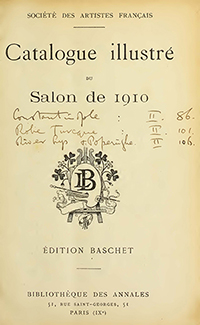
indications are that the Mond version remained in the family until the 1970s.42Arthur Sydney Baillieu, who also commissioned paintings by Streeton,43 died the same year as the artist, in 1943.44 He is established as the painting’s original owner by his 1914 purchase, the painting’s inclusion in the Loan Exhibition of the Works of Arthur Streeton in 1931–32, and through his will of 1943.45 The painting was situated in Baillieu’s South Yarra home in a stately room carrying Persian carpets, and portraits of Napoleon’s conqueror, British Admiral, Lord Nelson.46 Baillieu is the father of the major Australian art patron Sunday Reed; it is interesting to know that this grand and significant Streeton painting once graced the family home of this influential figure, who laid the foundations for the Heide Museum of Modern Art.
The Grand Canal holds a central place in Australian art history, with far-reaching relevance, not least as an example of collecting taste in the early twentieth century, reflected here by one of the nation’s most prominent families. It featured strikingly in the recent exhibition, Streeton, at the Art Gallery of New South Wales as a key work, and the most important of the Venetian paintings.
This remarkable painting represents the very pinnacle of Streeton’s Venetian series and indeed, of his extensive body of European work.
DR SARAH SCHMIDT
Dr. Sarah Schmidt is an Australian public gallery director and curator. Schmidt, who is Director of Canberra Museum and Gallery and the Commonwealth’s Nolan Collection, previously managed cultural diplomacy at the Australian Embassy, Beijing, was Director of Hamilton Gallery, and Deputy Director of the Art Gallery of Ballarat.
Grand Canal, Venice.jpg
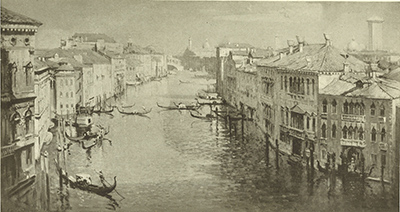
The Nora Clench Quartet, London, 1904.jpg
